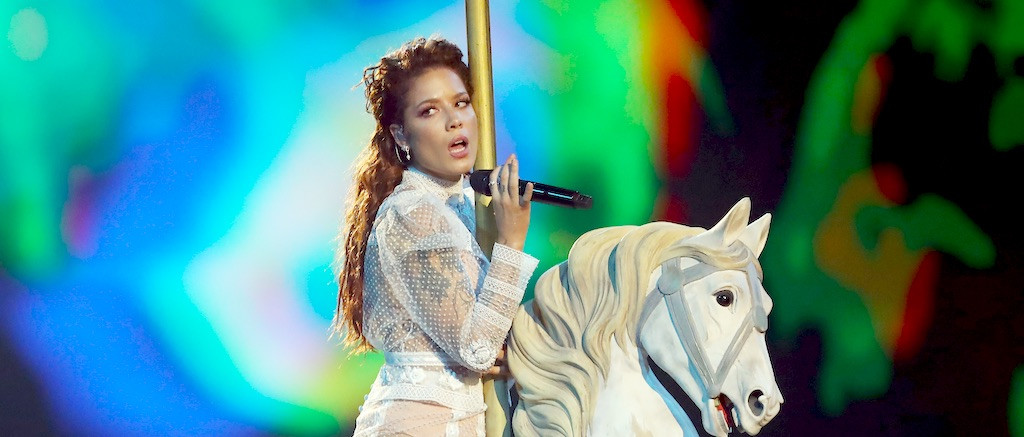Halsey has become one of the biggest names worldwide and cemented herself as one of the most diverse artists in her field. With her third studio album MANIC just days away from being released, we decided to take a trip down memory lane to see the true musical evolution of Halsey.
ROOM 93
In 2014, Halsey truly made a statement with her first EP Room 93 that caught much attention online. Lead by one of her most well-known tracks Ghost, the electropop driven mix was a bold yet cohesive move for the star and the EP brought her a wave of new fans who resonated with the body of work. Room 93‘s heavy production does not shy away from the raw and heartbreaking lyrical content of the work. Heartbreak and loneliness are at the forefront of the themes within this release, Is There Somewhere touches on being second best to your lover and being their secret while Trouble discusses the toxicity of certain relationships that centre around hurting you. Her bold debut EP laid out the foundations of what is at the core of Halsey’s music: rawness and honesty.
BADLANDS
Badlands marked a further turning point in launching her career into the mainstream. The debut album focused on the fictional ‘badlands’ that Halsey described as her state of mind and escape from reality, with her lyrics overflowing with the discussion of her mental health (Control, Gasoline), failing relationships (Colors, Coming Down) and commentary on pop culture (New Americana.) Continuing with her electropop sound from Room 93 (and the inclusion of Ghost and Hurricane), Badlands was an easy progression with her career but that did not stop her experimenting more with her artistry. Album opener Castle samples orchestral pop while Control can be defined as dark pop due to the overwhelming intensity that builds up across the track. The concept album solidified Halsey as a progressive player in the pop industry and opened the floodgates for her to only further challenge herself on the follow-up records.
Hopeless Fountain Kingdom
Hopeless Fountain Kingdom (HFK) is where Halsey really began to push her boundaries as an artist and a creative. HFK opened up for Halsey to tell the story of her removing herself from a toxic relationship and enter a journey of self-love, highlighted on tracks such as the heavy trap-inspired Don’t Play; telling the story of her realising she is better off alone than trapped in this relationship. HFK was also one of the first times that the singer began to fully be raw and vulnerable; piano ballad Sorry opens up about her feelings of never being truly loved. While her first big solo hit Bad at Love was a standout track highlighting her previous relationships and own faults within them and being a bisexual anthem that made it in the mainstream.
Another key creative twist for the album was the inclusion of the ongoing Romeo and Juliet inspired storyline, highlighted especially on The Prologue and Good Mourning., helping create a full storytelling experience on the record. While the album is still rooted in pop and features elements of electropop from her previous work, Halsey pushed herself more into synth-pop and R’n’B influences were sprinkled across the record showing a more mature sound during the two-year gap between albums.
MANIC
Approaching the MANIC era, Halsey had stated that this would be her most open and experimental era yet, telling Rolling Stone the record is “hip-hop, rock, country, f*****g everything — because it’s so manic. It’s soooooo manic.” Stepping away from her usual concept albums, MANIC is an album created by Ashley on her own terms. This era is about her breaking out of the ‘alternative pop’ box that she has been kept in and standing her ground doing whatever she feels is best. Be it the punk-inspired Nightmare (while it is not on the album, it is still a great song), or stepping into the country breakup track You should be sad, this is by far the stars most diverse and honest era to date. Further tracks such as Clementine hints towards her bipolar disorder, the gorgeous Finally // beautiful stranger is her first ‘falling-in-love’ song in her six-year-long career and the collaboration between Halsey and Suga of BTS fittingly titled SUGA’s interlude discusses the struggles of being in the spotlight.
While there are still 10 unheard songs (13 if you count the deluxe and Japanese editions), it is clear by the released tracks that this album is a career-defining moment for the megastar.
Let us know which Halsey era is your favourite by tweeting the CelebMix account!

